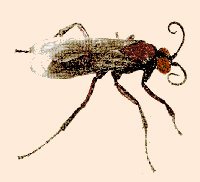
The Hazards of Colonizing Species
By Jack Bowman Ó 1999
SOLITARY WASP
|
The Hazards of Colonizing Species By Jack Bowman Ó 1999 |
During the spring and summer of 1999 I observed two Red Wasp building their nest. One of them built it's nest on the screen of the attic vent. The other built it's nest inside the gas door of my 1986 Escort.
The one that built the nest on the screen only had a few cells when the eggs/larva was eaten by a bird.
The one that built the nest inside the door of the Escort prospered and there were numerous cells and numerous wasp by September.
| The photo to the right is the wasp nest in its location. The photo to the right of it is a detail of the bird marks as it was torn apart. |
|
|
|
This is the wasp nest inside the fuel door of the 1986 Escort. There were numerous cells and numerous adult wasp by the beginning of September. |
These were the same species of wasp. However the one that built the nest inside the fuel door was on the verge of building nest differently and more like the Honey Bee or the Yellow Jacket. The door was closed all summer but the wasp could go in around the edge of the closed door. There was also some light coming in from the bottom of the fender. So it wasn't totally like a Honey Bee or Yellow Jacket. It did offer protection from large and I assume common predators like birds.
Did the successful wasp adapt. I really don't know because I cannot totally get into his mind. I would think that he had a requirement of light. The light was still there. The fact that he probably entered a small hole to get into the gas cap area is unusual. He could have entered from underneath the fender and therefore his probably requirement of (fly directly to the nest) was met. I did see wasp fly out from around the closed door. That is how I initially found the nest. My son told me "there was a wasp that just flew into your gas cap". So, even though the initial decision to build the nest in a protected area could have came by flying directly in from underneath the fender the was later flew out a small (wasp size) opening.
Here we should consider another aspect of the Colonizing Wasp life. First of all he requires a large nest area. He needs room. By requiring more room than a solitary species then he is easier to find than a solitary species. In the first case he was found by the bird. In the second case, since there were many of them entering and exiting the nest area in the successful nest the chances of a predator seeing them and finding the nest is greater. In this case my son saw one of the ten or more that occupied the successful nest fly into it. So the solitary species has a much greater chance of concealing the nest area and his offspring.